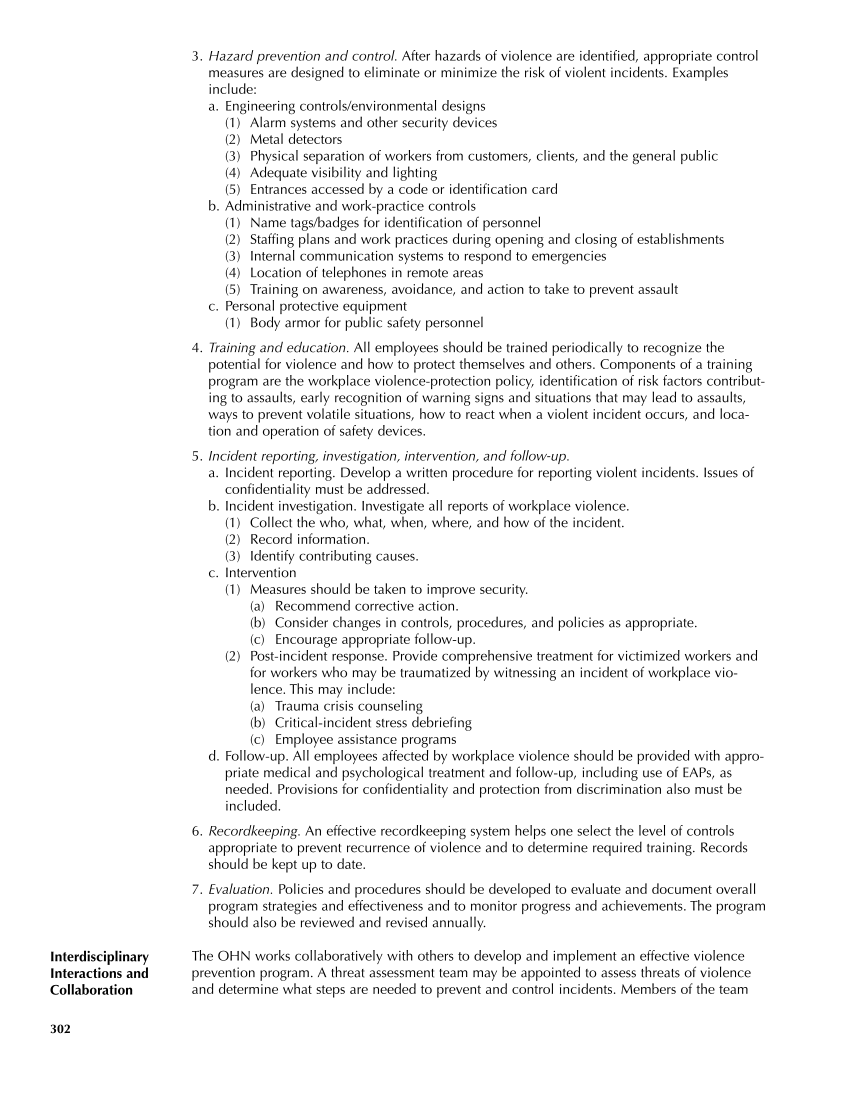3. Hazard prevention and control. After hazards of violence are identified, appropriate control measures are designed to eliminate or minimize the risk of violent incidents. Examples include: a. Engineering controls/environmental designs (1) Alarm systems and other security devices (2) Metal detectors (3) Physical separation of workers from customers, clients, and the general public (4) Adequate visibility and lighting (5) Entrances accessed by a code or identification card b. Administrative and work-practice controls (1) Name tags/badges for identification of personnel (2) Staffing plans and work practices during opening and closing of establishments (3) Internal communication systems to respond to emergencies (4) Location of telephones in remote areas (5) Training on awareness, avoidance, and action to take to prevent assault c. Personal protective equipment (1) Body armor for public safety personnel 4. Training and education. All employees should be trained periodically to recognize the potential for violence and how to protect themselves and others. Components of a training program are the workplace violence-protection policy, identification of risk factors contribut- ing to assaults, early recognition of warning signs and situations that may lead to assaults, ways to prevent volatile situations, how to react when a violent incident occurs, and loca- tion and operation of safety devices. 5. Incident reporting, investigation, intervention, and follow-up. a. Incident reporting. Develop a written procedure for reporting violent incidents. Issues of confidentiality must be addressed. b. Incident investigation. Investigate all reports of workplace violence. (1) Collect the who, what, when, where, and how of the incident. (2) Record information. (3) Identify contributing causes. c. Intervention (1) Measures should be taken to improve security. (a) Recommend corrective action. (b) Consider changes in controls, procedures, and policies as appropriate. (c) Encourage appropriate follow-up. (2) Post-incident response. Provide comprehensive treatment for victimized workers and for workers who may be traumatized by witnessing an incident of workplace vio- lence. This may include: (a) Trauma crisis counseling (b) Critical-incident stress debriefing (c) Employee assistance programs d. Follow-up. All employees affected by workplace violence should be provided with appro- priate medical and psychological treatment and follow-up, including use of EAPs, as needed. Provisions for confidentiality and protection from discrimination also must be included. 6. Recordkeeping. An effective recordkeeping system helps one select the level of controls appropriate to prevent recurrence of violence and to determine required training. Records should be kept up to date. 7. Evaluation. Policies and procedures should be developed to evaluate and document overall program strategies and effectiveness and to monitor progress and achievements. The program should also be reviewed and revised annually. The OHN works collaboratively with others to develop and implement an effective violence prevention program. A threat assessment team may be appointed to assess threats of violence and determine what steps are needed to prevent and control incidents. Members of the team 302 Interdisciplinary Interactions and Collaboration
Purchased from OEM Press by (ge corporate access). (C) 2013 OEM Health Information, Inc. All rights reserved.












































































































































































































































































































































































































































